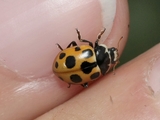Підтримуємо Вільну Україну
 We Support Free Ukraine
We Support Free Ukraine

Biodiversity Map
Taxa

Ceratomegilla — subordinate taxa:
Taxon count: 2
-
Arthropodaphylum
Click to switch
to select orders
and filters > -
Hexapodasubphylum
Click to switch
to select orders
and filters > -
Insectaclass
Click to switch
to select orders
and filters > -
Coleopteraorder
Click to set
as the main taxon
and as a base
← of the left panel > -
Polyphagasuborder
Click to set
as the main taxon
and as a base
← of the left panel > -
Cucujiformiaseries
Click to set
as the main taxon
and as a base
← of the left panel > -
Cucujoideasuperfamily
Click to set
as the main taxon
and as a base
← of the left panel > -
Coccinellidaefamily
Click to set
as the main taxon
and as a base
← of the left panel > -
Coccinellinaesubfamily
Click to set
as the main taxon
and as a base
← of the left panel > -
Coccinellinitribe
Click to set
as the main taxon
and as a base
← of the left panel > -
Ceratomegillagenus
Click to set
as the main taxon
and as a base
← of the left panel > -
Ceratomegillasubgenus
Click to set
as the main taxon
and as a base
← of the left panel >
PL
YES
name status: valid name
BioMap ID: 1019669
taxon code: 3601
taxonomy checked: YES
Data on distribution in Poland

Statistics
- Records: 64
- Publications: 24
- Collections: 11
- Publication authors: 31
- Illustrations (iconography): 1
- Photos (specimen/observation): 26
Taxon description
Gatunek borealno-górski, notowany z Norwegii, Finlandii, Karelii oraz obszarów górzystych w środkowej części Europy, w północnych Włoszech i Jugosławii, w Siedmiogrodzie, Azji Mniejszej i na Kaukazie. W Polsce znany z czterech, południowych krain i izolowanego stanowiska północnego na Pojezierzu Mazurskim. Spotyka się go w wilgotnych., silnie zacienionych, środowiskach — na krzaczastych, wierzbach, roślinach zielnych i bylinach, zwłaszcza na pokrzywie zwyczajnej — Urtica dioica L.
Illustrations
... browse
 Ceratomegilla
Ceratomegillanotata
Selected photos
... browse
 Ceratomegilla
Ceratomegillanotata
 Ceratomegilla
Ceratomegillanotata
 Ceratomegilla
Ceratomegillanotata
 Ceratomegilla
Ceratomegillanotata
 Ceratomegilla
Ceratomegillanotata
 Ceratomegilla
Ceratomegillanotata
 Ceratomegilla
Ceratomegillanotata
 Ceratomegilla
Ceratomegillanotata
External data sources
- Ostatnie rekordy
-
1041431
 ⊡
⊡ Coccinellidae: Ceratomegilla notata, PL, Podlasie, podlaskie, Białystok m., Białystok, UTM FD49, 2010, leg. A. Kołodko
Coccinellidae: Ceratomegilla notata, PL, Podlasie, podlaskie, Białystok m., Białystok, UTM FD49, 2010, leg. A. Kołodko -
1035294
 ⊡
⊡ Coccinellidae: Ceratomegilla notata, PL, Podlasie, podlaskie, Białystok, Wasilków, UTM FD49, 2013, leg. A. Kołodko
Coccinellidae: Ceratomegilla notata, PL, Podlasie, podlaskie, Białystok, Wasilków, UTM FD49, 2013, leg. A. Kołodko -
1035252
 ⊡
⊡ Coccinellidae: Ceratomegilla notata, PL, Podlasie, podlaskie, Białystok, Wasilków, UTM FE50, 2013, leg. A. Kołodko
Coccinellidae: Ceratomegilla notata, PL, Podlasie, podlaskie, Białystok, Wasilków, UTM FE50, 2013, leg. A. Kołodko -
1035251
 ⊡
⊡ Coccinellidae: Ceratomegilla notata, PL, Podlasie, podlaskie, Białystok, Wasilków, UTM FE50, 2013, leg. A. Kołodko
Coccinellidae: Ceratomegilla notata, PL, Podlasie, podlaskie, Białystok, Wasilków, UTM FE50, 2013, leg. A. Kołodko -
1035241
 ⊡
⊡ Coccinellidae: Ceratomegilla notata, PL, Podlasie, podlaskie, Białystok, Wasilków, UTM FD49, 2010, leg. A. Kołodko
Coccinellidae: Ceratomegilla notata, PL, Podlasie, podlaskie, Białystok, Wasilków, UTM FD49, 2010, leg. A. Kołodko -
1035168
 ⊡
⊡ Coccinellidae: Ceratomegilla notata, PL, Podlasie, podlaskie, Białystok m., Białystok, UTM FD49, 2010, leg. A. Kołodko
Coccinellidae: Ceratomegilla notata, PL, Podlasie, podlaskie, Białystok m., Białystok, UTM FD49, 2010, leg. A. Kołodko -
1035066
 ⊡
⊡ Coccinellidae: Ceratomegilla notata, PL, Podlasie, podlaskie, Białystok, Wasilków, UTM FE50, 2012, leg. A. Kołodko
Coccinellidae: Ceratomegilla notata, PL, Podlasie, podlaskie, Białystok, Wasilków, UTM FE50, 2012, leg. A. Kołodko -
1035055
 ⊡
⊡ Coccinellidae: Ceratomegilla notata, PL, Podlasie, P.K. Puszczy Knyszyńskiej im. profesora Witolda Sławińskiego, podlaskie, Białystok, Czarna Białostocka, UTM FE50, 2012, leg. A. Kołodko
Coccinellidae: Ceratomegilla notata, PL, Podlasie, P.K. Puszczy Knyszyńskiej im. profesora Witolda Sławińskiego, podlaskie, Białystok, Czarna Białostocka, UTM FE50, 2012, leg. A. Kołodko -
1034938
 ⊡
⊡ Coccinellidae: Ceratomegilla notata, PL, Podlasie, podlaskie, Białystok m., Białystok, UTM FD49, 2011, leg. A. Kołodko
Coccinellidae: Ceratomegilla notata, PL, Podlasie, podlaskie, Białystok m., Białystok, UTM FD49, 2011, leg. A. Kołodko -
1034930
 ⊡
⊡ Coccinellidae: Ceratomegilla notata, PL, Podlasie, podlaskie, Białystok, Supraśl, UTM FD59, 2011, leg. A. Kołodko
Coccinellidae: Ceratomegilla notata, PL, Podlasie, podlaskie, Białystok, Supraśl, UTM FD59, 2011, leg. A. Kołodko - ... more
- Powiązane publikacje
-
Marczak D. 2010c. Stan poznania biedronek (Coleoptera: Coccinellidae) Kampinoskiego Parku Narodowego. Wiad. Entomol., 29(Supl.):135-140.
 full text
full text Show records
Show records -
Bubienko K., Kosewska A., Ciepielewska D. 2010. Ladybirds (Coleoptera, Coccinellidae) of midfield thickets. Aphids and Other Hemipterous Insects, 16:107-117.
 Show records
Show records -
Ruta R., Jałoszyński P., Konwerski Sz., Majewski T. [2], Barłożek T. 2009. Biedronkowate (Coleoptera: Coccinellidae) Polski. Część 1. Nowe dane faunistyczne. Wiad. Entomol., 28(2):91-112.
 full text
full text Show records
Show records -
Komosiński K., Browarski B., Bujnik B. 2009. Inwentaryzacja entomologiczna. [In:] Studium Techniczno-Ekonomiczno-Środowiskowe. Etap I dla inwestycji polegającej na rozbudowie drogi krajowej nr 16 na odcinku Sorkwity-Mrągowo-Orzysz-Ełk - warianty dodatkowe. pp. 162-172.
 Show records
Show records -
Borowiec L., Kania J. 1996(1995)a. Chrząszcze (Coleoptera) nowe i rzadkie w faunie Bieszczadów. Wiad. Entomol., 14(3):153-157.
 full text
full text Show records
Show records - ... more






